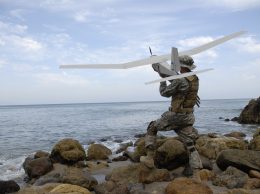Setting a course from Simi Valley to Mars
Before it could be loaded onto the rocket for its impending interplanetary launch, AeroVironment’s helicopter design had to thread a tight needle between weight and durability.
The mission, which is set to launch between July 30 and Aug. 15 with the Perseverance rover, will be a first-of-its-kind test flight of an aircraft on Mars. The initial demonstration project has already yielded new insights for the firm throughout its development, into the materials, integrated systems and testing capabilities needed to get it off the ground.
“We have really learned a lot from working at JPL,” AeroVironment senior aeromechanical engineer Benjamin Pipenberg said. “There’s a new level of detail when you’re throwing something halfway across the solar system at a new planet.”
The Simi Valley-based company has a long history of developing rugged unmanned aerial systems for military use, as well as high altitude systems that could be adapted to flight in the incredibly thin atmosphere of Mars.
The environment on the Red Planet is equivalent to the atmosphere at around 100,000 feet on Earth, or around 1 percent of sea level. At such a high altitude, “even some of the things like temperature profile and radiation are kind of equivalent to what’s on Mars,” Pipenberg said.
But designing a helicopter that could take flight on Mars meant first building one that could withstand the rigors of a rocket launch.
“A rocket launch is a really violent affair for a delicate little helicopter,” he said. “It needs to be extremely sturdy and extremely stiff and rigid, but also extremely light to fly in that Martian atmosphere, so that’s why it’s a difficult engineering problem. It has to be optimized to meet those mission requirements.”
Dubbed Ingenuity, the final product weighs only around four pounds, or less than two kilograms, but it had to be equipped with larger rotor blades that could spin much faster than a usual helicopter drone to generate sufficient lift.
The rover is expected to touch down on Mars in mid-February, with a first test flight for Ingenuity scheduled 60 days later, after initial system tests have been completed.
Flying it will also be a challenge, since round-trip signals between Earth and Mars are delayed by up to 40 minutes.
“Our whole flight happens before we know the helicopter is flown,” Pipenberg said. “The whole thing happens autonomously.”
Even before takeoff, the guidance navigation and control systems have to determine that the helicopter is safe, able to charge itself and stay warm at night, said Bob Balaram, chief engineer on the project at NASA Jet Propulsion Laboratory, which designed the software. Once it decides the conditions are correct for a takeoff, the NASA team can send it a heading.
Ingenuity is equipped with instruments to measure inertia and altitude as well as capture color imagery, but the project is intended to serve primarily as a technology demonstration.
“It’s our Wright brothers moment on Mars,” Pipenberg said. “The value outcome of this isn’t necessarily the data gathered by this helicopter.”
Much like the Sojourner rover that landed on Mars in 1997, Balaram said, a successful test launch would pave the way for larger systems. The next systems could weigh between 5 and 20 kilograms and could travel up to 20-30 meters per second and carry more significant scientific equipment.
“One thing helicopters do is give you that reach you would not be able to get to with a rover,” Balaram said. “With the helicopter, you can get up close and personal just like the rovers do, but over larger ranges and in places the rovers can’t get to.”
Cleanliness protocols were also new to AeroVironment, Pipenberg said, including safeguards to keep the Perseverance rover and its experiments free of contaminants. That meant the creation of a new cleanroom at AeroVironment’s Simi Valley site, and operating under strict observation by JPL’s contamination control group.
“That was a pretty big effort, standing up that facility and just learning the process to make space-qualified hardware,” Pipenberg said.
For JPL, testing the designs required new chambers and wind tunnels, as well as extensive vibration testing.
“How do you design a test program to test something that’s never been done before?” Balaram said. “How do you test an aircraft that also has to be a spacecraft? There is no book.”
In its most recent fiscal year, ended April 30, AeroVironment reported $367.3 million in revenue, a 17 percent gain over the prior year, driven by strong demand for its small unmanned aerial systems. Shares ended July 22 just down from their 52-week high at $76.33, a 21 percent gain since the start of the year.
“It’s a tremendously interesting kind of project that attracts engineers and technical talent to the company,” said Steve Gitlin, AeroVironment’s chief marketing officer. “It gives us the ability to attract a whole new cadre of talent to the company, and that’s very important to be able to fulfill our growth goals.”
The company declined to discuss the profitability of individual projects, but said the research pays dividends in the form of future development of projects like its high-altitude pseudo-satellite, or HAPS system, being designed in partnership with Japanese tech investor Softbank.
“It could open up possibilities of new types of planetary probes for Mars and other objects in our solar system,” Gitlin said, adding that the company hopes to play a role in that future development.
— Contact Marissa Nall at [email protected]











